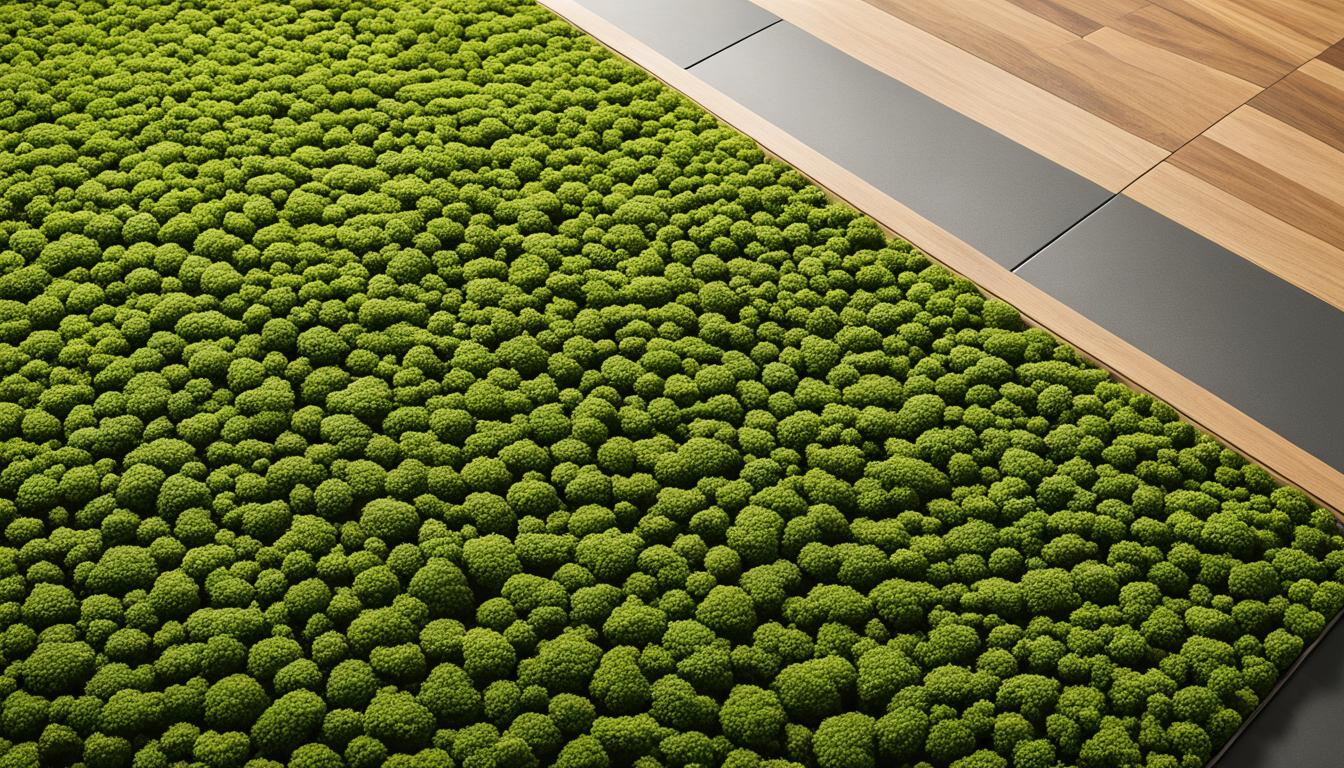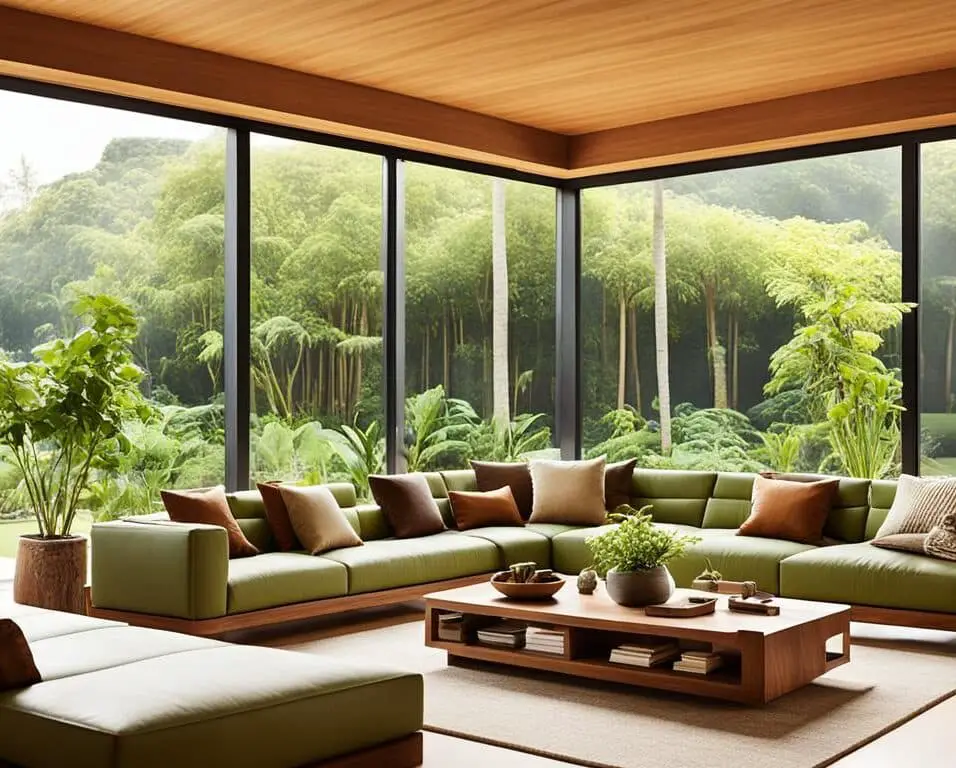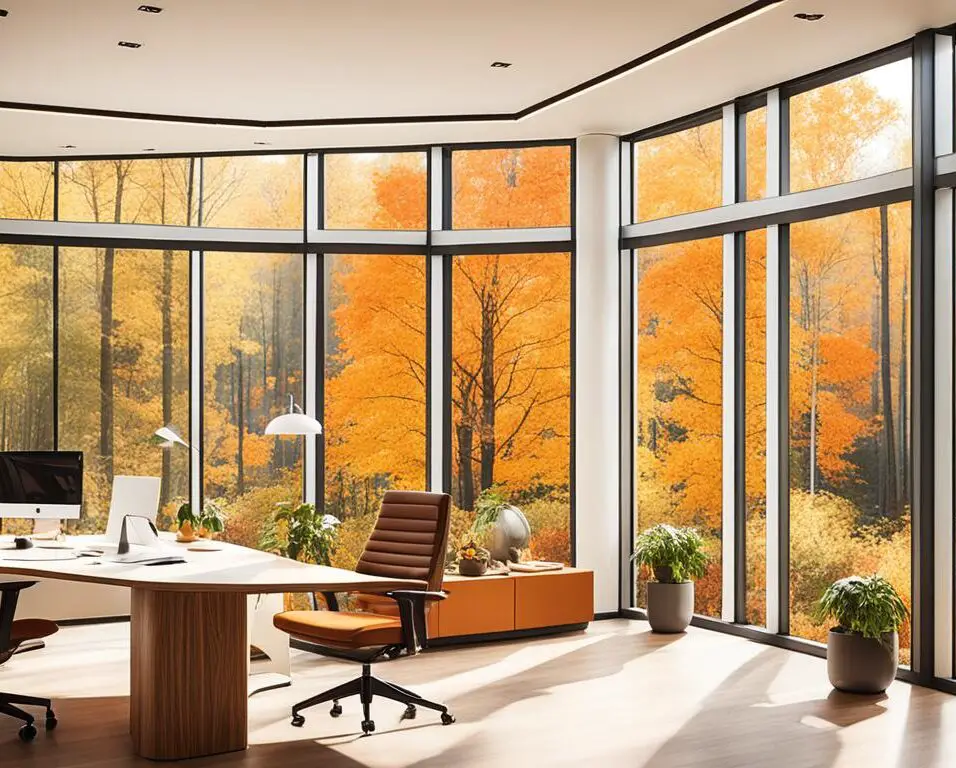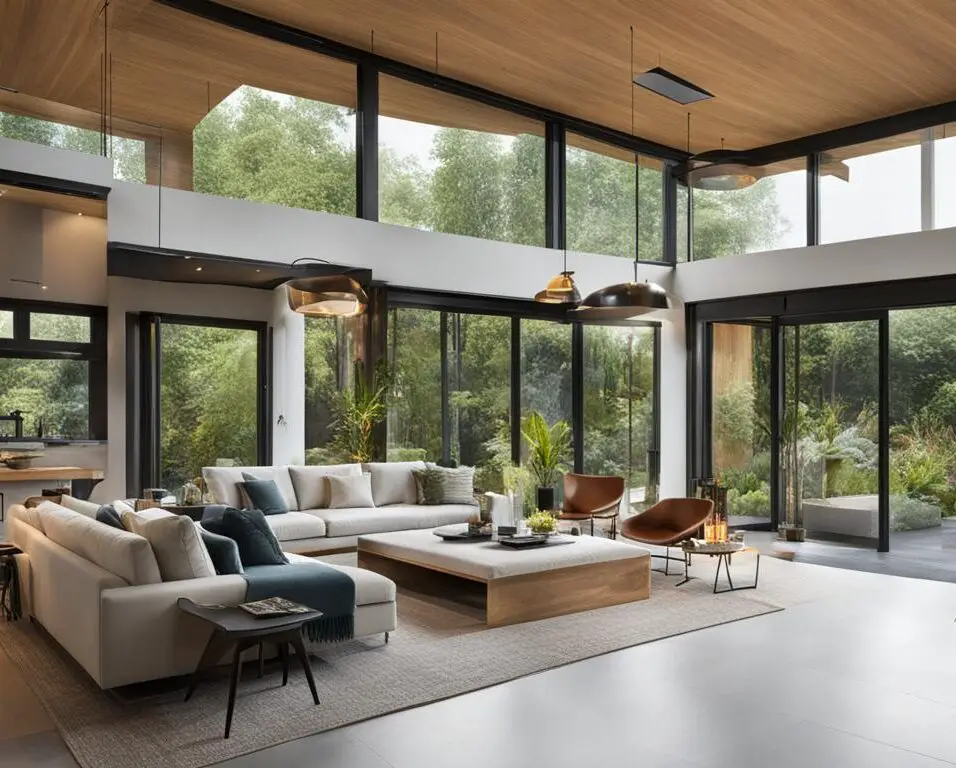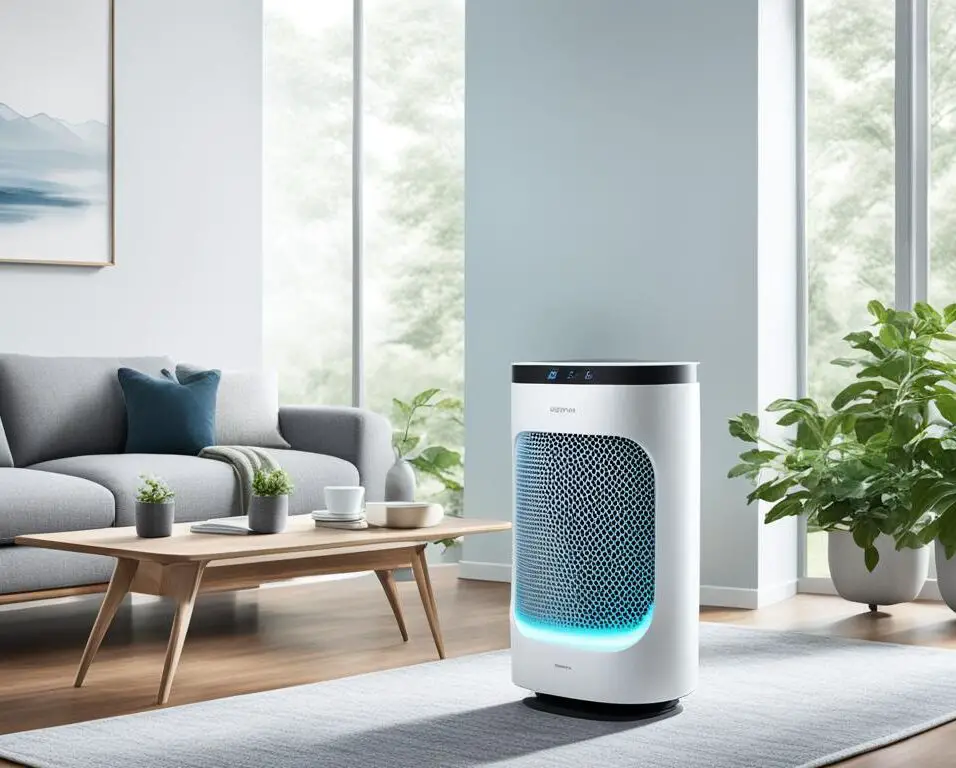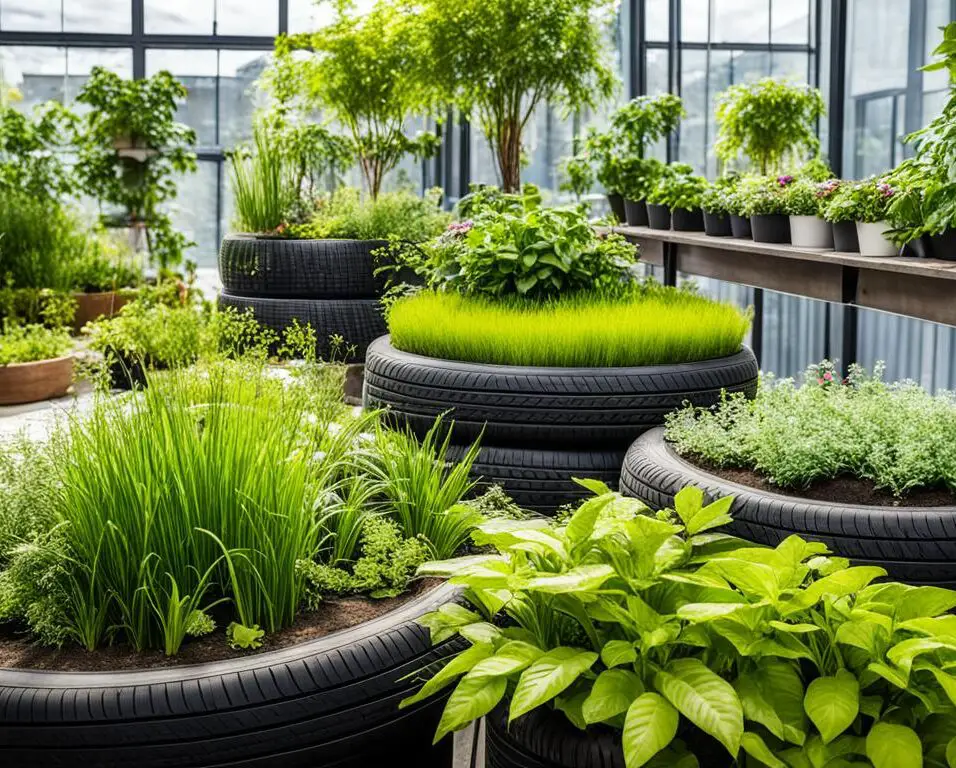Grounded Innovation: Biophilic Flooring in Modern Design
As a modern design enthusiast, I am constantly on the lookout for the latest trends that harmonize functionality, aesthetics, and sustainability. One trend that has caught my attention is the integration of biophilic design principles into interior spaces. The concept of biophilic design revolves around bringing nature indoors, creating spaces that promote well-being and connectivity with the natural world.
One aspect of biophilic design that has particularly piqued my interest is the innovative flooring options that are now available in the market. These flooring solutions are not only visually stunning but also offer a range of benefits, from improved air quality to enhanced comfort and versatility.
Key Takeaways:
- Innovative flooring is a vital component of biophilic design in modern interiors.
- Biophilic flooring options bring the beauty of nature indoors and enhance the overall well-being of occupants.
- These flooring solutions offer numerous benefits, including sustainability, aesthetics, and improved air quality.
- The integration of natural elements through flooring creates nature-infused sanctuaries for modern living.
- Stay tuned as we delve deeper into the world of biophilic flooring in modern design.
>The Importance of Sustainable Health Care Design>
>Sustainable health care design is a crucial aspect of today’s architectural landscape. With a focus on creating efficient and environmentally friendly health care facilities, sustainable design aims to minimize the negative environmental impact while improving patient comfort and well-being. This approach recognizes the responsibility to reduce carbon emissions and resource consumption in the built environment, making sustainable practices essential for all buildings, including health care facilities. While ensuring energy efficiency in health care design can be challenging due to the unique needs and energy requirements of these facilities, innovative strategies and technologies are being implemented to achieve sustainability.>
>By adopting sustainable health care design principles, such as incorporating renewable energy sources, optimizing water usage, and prioritizing energy-efficient systems, health care facilities can significantly reduce their environmental footprint. These measures not only contribute to global sustainability efforts but also help lower operational costs and create healthier spaces for patients and staff. The use of energy-efficient lighting, HVAC systems, and insulation can go a long way in reducing energy consumption and minimizing environmental impact. Moreover, sustainable health care design also considers the selection of eco-friendly materials and incorporates sustainable waste management practices in the construction and operation of health care facilities.>
>Taking into account the environmental impact of health care facilities is crucial in creating healthier communities and promoting sustainable development. According to the U.S. Environmental Protection Agency, health care facilities are one of the largest energy consumers in the commercial sector, accounting for a significant portion of greenhouse gas emissions. By implementing sustainable design strategies, such as the use of renewable energy sources, efficient water management, and green building materials, health care facilities can not only reduce their environmental impact but also set an example for other industries to follow.>
>The Environmental Impact of Sustainable Health Care Design>
>One of the primary goals of sustainable health care design is to minimize the environmental impact of these facilities. This includes reducing carbon emissions, conserving resources, and minimizing waste generation. By implementing energy-efficient systems, health care facilities can significantly reduce their carbon footprint. Energy-efficient lighting, HVAC systems, and appliances not only reduce energy consumption but also lower greenhouse gas emissions. Furthermore, the use of renewable energy sources, such as solar panels or geothermal systems, can further contribute to environmental sustainability.>
>Water conservation is another critical aspect of sustainable health care design. By incorporating efficient plumbing fixtures and implementing water management systems, health care facilities can reduce water usage and minimize strain on local water resources. Conserving water not only lowers costs but also supports the overall well-being of the community. Additionally, sustainable health care design practices can include rainwater harvesting systems or greywater reuse projects, further minimizing water waste.>
>The choice of materials in health care construction also plays a significant role in sustainable design. Using eco-friendly materials, such as recycled content or sustainably sourced products, reduces the environmental impact associated with resource extraction and manufacturing. Additionally, incorporating renewable materials, such as bamboo or cork, can promote sustainability while adding a touch of natural beauty to the interior spaces. The proper management of construction and operational waste is another crucial aspect of sustainable health care design, ensuring that materials are appropriately recycled or disposed of to minimize the environmental impact.>
| Environmental Impact Areas | Sustainable Health Care Design Solutions |
|---|---|
| Energy | Implementation of energy-efficient lighting and HVAC systems, use of renewable energy sources like solar panels, and efficient insulation. |
| Water | Installation of water-efficient fixtures, implementation of water management systems, rainwater harvesting, and greywater reuse projects. |
| Materials | Utilization of eco-friendly materials, including recycled content and sustainably sourced products, as well as proper waste management practices. |
| Waste | Implementation of recycling and waste management systems, ensuring proper disposal and diversion of construction and operational waste. |
Examples of Sustainable Health Care Design
When it comes to sustainable health care design, there are numerous inspiring examples that demonstrate the successful integration of renewable energy sources, daylighting solutions, and sustainable materials. These examples showcase how sustainability principles can be applied in health care facilities to create environments that are both environmentally friendly and conducive to healing.
Richard M. Schulze Family Foundation ACS Hope Lodge
The Richard M. Schulze Family Foundation ACS Hope Lodge in Houston is a prime example of sustainable health care design. This facility was designed with a specific focus on daylighting and energy efficiency, aiming to maximize the use of natural light and reduce the energy consumption of artificial lighting. The incorporation of large windows and skylights allows for ample daylight to flood the interior spaces, creating a bright and uplifting atmosphere for patients and staff alike.
Rancho Los Amigos Recuperative Care Campus
The Rancho Los Amigos Recuperative Care Campus in Downey, California is another notable example of sustainable health care design. This facility showcases the integration of water-wise landscaping and renewable energy sources. The use of native and drought-tolerant plants, smart irrigation systems, and rainwater harvesting techniques contribute to water conservation efforts. Additionally, the campus incorporates solar panels and other renewable energy technologies to reduce its reliance on traditional energy sources, further enhancing its sustainability.
Cedars-Sinai’s Los Feliz Urgent Care Clinic
The Cedars-Sinai’s Los Feliz Urgent Care Clinic in Los Angeles is a prime example of sustainable health care design that embraces local culture and incorporates sustainable materials and design elements. The clinic’s design incorporates reclaimed wood, recycled materials, and low-VOC paints to minimize environmental impact. The integration of sustainable materials not only contributes to the clinic’s sustainability but also enhances the overall aesthetics and ambiance of the space.
These examples of sustainable health care design demonstrate the possibilities and benefits of incorporating renewable energy sources, daylighting solutions, and sustainable materials into health care facilities. By prioritizing sustainability, these facilities not only reduce their environmental footprint but also create healing environments that promote the well-being of patients and staff alike.
| Facility | Location | Design Features |
|---|---|---|
| Richard M. Schulze Family Foundation ACS Hope Lodge | Houston | Daylighting and energy efficiency |
| Rancho Los Amigos Recuperative Care Campus | Downey, California | Water-wise landscaping and renewable energy sources |
| Cedars-Sinai’s Los Feliz Urgent Care Clinic | Los Angeles | Sustainable materials and design elements |
Emerging Interior Design Trends for 2024
As we move into 2024, the world of interior design continues to evolve, with a growing emphasis on sustainability and the use of natural materials. Designers and homeowners alike are increasingly seeking ways to create spaces that not only look beautiful but also align with eco-conscious principles. Let’s explore some of the emerging interior design trends for 2024 that are shaping the way we live and interact with our surroundings.
Sustainable Materials and Natural Aesthetics
One of the key trends in interior design for 2024 is the use of sustainable materials and a focus on natural aesthetics. There is a growing demand for furniture and decor made from renewable resources, such as recycled materials, reclaimed wood, and organic textiles. This shift towards sustainable materials not only helps reduce our ecological footprint but also brings a sense of warmth and authenticity to living spaces.
Designers are incorporating natural elements, such as indoor plants, stone accents, and organic textures, to create a connection with the outdoors. This biophilic design approach not only enhances the visual appeal of a space but also promotes well-being by fostering a sense of calm and harmony.
Textured Wood and Earthy Tones
In 2024, textured wood is making a comeback in interior design. Whether it’s a rustic farmhouse-style dining table or a contemporary textured wood wall paneling, this trend adds depth and visual interest to spaces. Textured wood not only brings a touch of nature indoors but also complements a wide range of design aesthetics, from modern to bohemian.
Earthy tones are another prominent feature in interior design trends for 2024. Shades of brown, beige, and terracotta are being used in upholstery, wall paint, and decor to create a warm and inviting atmosphere. These natural hues evoke a sense of tranquility and are versatile enough to be paired with bolder accents or used as a neutral backdrop.
Functional and Ergonomic Design
In response to changing lifestyles and the increasing demand for flexible workspaces, functional and ergonomic design is gaining momentum. As more people work remotely or require multi-functional spaces, the design industry is focusing on creating home offices that seamlessly integrate with the overall living environment.
Designers are incorporating innovative storage solutions, convertible furniture, and comfortable seating options to optimize space usage without sacrificing style. Additionally, ergonomic principles are being applied to furniture design, ensuring that home offices are not only aesthetically pleasing but also promote productivity and well-being.
Pop-Art Flowers and Fluted Walls
In 2024, expect to see a resurgence of pop-art flowers in interior design. Oversized floral prints and vibrant botanical motifs are being used in wallpapers, upholstery, and artwork to bring a playful and energetic vibe to spaces. This trend adds a touch of whimsy and can be incorporated in small doses or as a bold statement piece.
Fluted walls, characterized by vertical grooves or ridges, are also set to make a splash in interior design. This architectural feature adds texture and visual interest to walls and can be incorporated in various design styles, from contemporary to Art Deco. Fluted walls offer a unique way to introduce dimension and create a focal point in a room.
Emerging Interior Design Trends for 2024
| Trend | Description |
|---|---|
| Textured Wood | Incorporating textured wood in furniture and decor adds depth and visual interest to living spaces |
| Earthy Tones | Shades of brown, beige, and terracotta create warm and inviting atmospheres |
| Functional and Ergonomic Design | Creating multi-functional and ergonomic spaces to accommodate remote work and changing lifestyles |
| Pop-Art Flowers | Oversized floral prints and vibrant botanical motifs bring a playful and energetic vibe to interiors |
| Fluted Walls | Vertical grooves or ridges on walls add texture and create a focal point in a room |
These emerging trends in interior design for 2024 reflect a growing awareness and commitment towards sustainability, natural materials, and the integration of nature into our living spaces. By incorporating these trends, homeowners and designers can create visually stunning, functional, and eco-friendly environments that promote well-being and harmony with the natural world.
The Serenity of Silent Spaces in Interior Design
Silent spaces, characterized by minimal acoustic disturbances, have a profound impact on well-being and have become a fundamental element in contemporary interior design. Understanding the essence of silent spaces involves appreciating their historical and cultural significance. Silent design incorporates various elements to minimize noise and promote tranquility, including minimalistic architecture, sound-reducing materials, neutral color palettes, and the integration of natural elements through biophilic design principles. These elements work together to create spaces that foster mindfulness and concentration, offering individuals a sanctuary of calmness and peace.
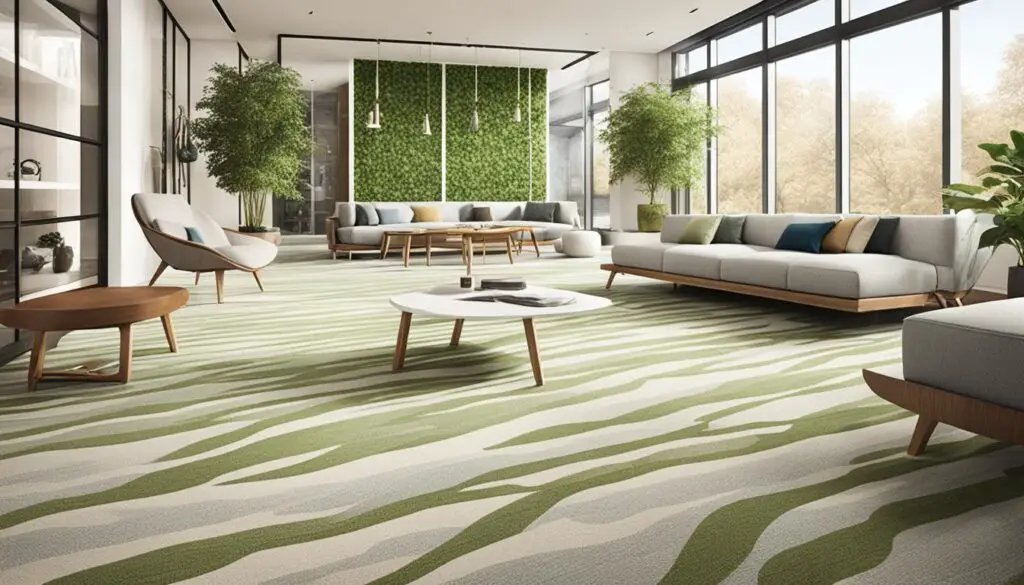
The use of silent design techniques in interior spaces creates an atmosphere conducive to relaxation and reflection. Minimalistic architecture eliminates unnecessary clutter and distractions, allowing the mind to focus on the present moment. Sound-reducing materials, such as acoustic panels and insulation, absorb and dampen external noises, ensuring a tranquil environment.
Neutral color palettes, consisting of soft hues and earthy tones, evoke a sense of serenity and balance. These colors have a calming effect on the mind and help create a harmonious space. By integrating natural elements, such as plants, water features, and natural textures, silent spaces establish a connection with the natural world, promoting a sense of grounding and well-being.
Harnessing the power of biophilic design principles further enhances the serenity of silent spaces. Biophilic design seeks to reconnect individuals with nature by incorporating natural elements into the built environment. By integrating biophilic elements, such as living walls, daylighting solutions, and views of nature, silent spaces bring the outdoors indoors, creating an immersive and serene experience.
The Benefits of Silent Spaces in Interior Design
The incorporation of silent spaces in interior design offers numerous benefits for individuals seeking respite from the noise and distractions of daily life. These spaces provide a haven for relaxation, rejuvenation, and reflection.
- Mental Well-being: Silent spaces offer a reprieve from the constant sensory stimulation of the modern world, allowing individuals to find solace and focus their thoughts. These spaces promote mental clarity, reduce stress levels, and enhance overall well-being.
- Improved Concentration: By minimizing distractions and creating a peaceful environment, silent spaces enhance concentration and productivity. The absence of excessive noise allows individuals to fully immerse themselves in tasks, fostering a state of flow.
- Enhanced Creativity: Silent spaces provide a conducive environment for creativity and inspiration. The serenity and calmness of these spaces stimulate imagination and encourage innovative thinking.
- Restorative Qualities: Spending time in silent spaces can have a restorative effect on both the mind and body. These spaces allow individuals to recharge, relax, and find inner peace, leading to improved overall health and well-being.
The integration of silent spaces in interior design promotes a holistic approach to well-being, nurturing the mind, body, and spirit. These spaces serve as a retreat from the noise and chaos of the outside world, creating a harmonious sanctuary for personal growth and self-reflection.
Examples of Silent Spaces in Interior Design
| Space | Description |
|---|---|
| Japanese Tea Room | A traditional Japanese tea room embodies the principle of silent spaces through its simple design, serene atmosphere, and focus on mindfulness. |
| Meditation Room | Dedicated meditation rooms provide a quiet and peaceful space for individuals to practice mindfulness and cultivate a sense of inner calm. |
| Library | Libraries, with their tranquil ambiance and minimal noise levels, create an ideal environment for reading, studying, and contemplation. |
These examples demonstrate how silent spaces can be incorporated into various interior settings, fostering a sense of tranquility and serenity.
In the title of H2 and table, there should be no “Section:” or “Table:”, only clean, beautiful names.
Bringing Nature into Silent Spaces
The connection between nature and tranquility lies at the core of creating serene silent spaces. Incorporating nature into interior environments not only enhances their serenity but also fosters a rejuvenating atmosphere. To achieve this, designers can leverage the principles of biophilic design, which emphasize the integration of natural elements. Creating indoor gardens, maximizing the use of natural light, and employing earthy materials are essential steps in establishing a strong connection with nature within these spaces. Additionally, incorporating nature views and introducing greenery further enhances the calming effect of silent spaces, creating an environment that resonates with the refreshing essence of the outdoors. By seamlessly integrating these natural elements into interior design, designers can provide occupants with a sanctuary of tranquility.
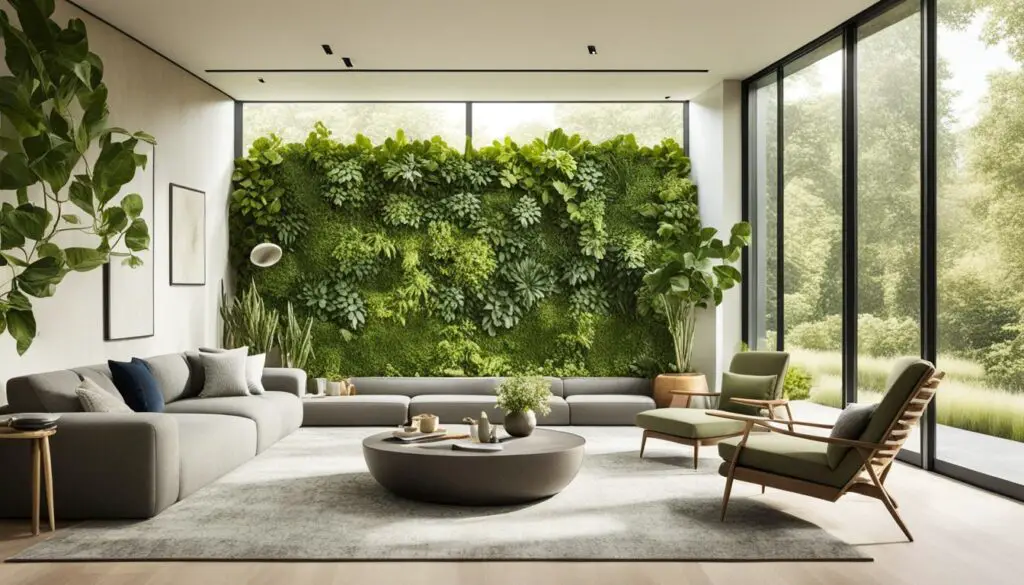
Benefits of Biophilic Design in Silent Spaces
Biophilic design, with its focus on bringing elements of nature into interior spaces, offers several benefits within silent spaces:
- Promotes relaxation and stress reduction
- Improves mental well-being and cognitive function
- Enhances productivity and concentration
- Boosts air quality and overall indoor environment
Incorporating biophilic design principles in silent spaces not only creates visually pleasing environments but also contributes to the physical and mental well-being of occupants.
Examples of Biophilic Design in Silent Spaces
Let’s explore some examples of how biophilic design has been successfully implemented in creating serene silent spaces:
| Space | Biophilic Design Elements |
|---|---|
| Wellness Retreat | Indoor living plant walls, large windows for natural light, and natural materials such as wood and stone. |
| Meditation Room | Zen garden, skylights for natural illumination, and a color palette inspired by nature. |
| Spa | Water features, pebble flooring, and organic shapes and textures. |
These examples demonstrate how integrating biophilic design principles into silent spaces can create harmonious environments that enhance well-being and immerse occupants in nature’s soothing embrace.
Conclusion
In conclusion, the integration of innovative biophilic flooring in modern design is a transformative approach to creating nature-infused living spaces. By incorporating sustainable health care design principles, embracing emerging interior design trends, and harnessing the serenity of silent spaces, designers can elevate the overall well-being, aesthetics, and sustainability of interior environments.
Biophilic flooring options not only bring the beauty of nature indoors but also contribute to a healthier and more environmentally friendly built environment. The use of natural materials, such as wood and stone, along with the incorporation of biophilic design principles like the maximization of natural light and the inclusion of indoor gardens, foster a deep connection with nature.
As we move into the future, the integration of innovative biophilic flooring in modern design will continue to play a significant role in creating harmonious and nature-inspired living spaces. From healthcare facilities to residential and commercial spaces, the presence of biophilic flooring enhances the visual appeal, promotes well-being, and supports sustainability goals. By truly immersing ourselves in nature-infused living spaces, we can experience the transformative power of biophilic design in our daily lives.
FAQ
What is biophilic design?
Biophilic design is an approach to interior design that incorporates natural elements into indoor spaces, creating a connection with nature. It focuses on bringing the beauty and benefits of nature indoors.
What are the benefits of innovative flooring in biophilic design?
Innovative flooring in biophilic design not only enhances the aesthetics of a space but also has numerous benefits. It contributes to sustainability by using eco-friendly materials and manufacturing processes. It improves well-being by creating a calming and rejuvenating environment. Additionally, it promotes a closer connection with nature, which has been proven to reduce stress and increase productivity.
How does sustainable health care design differ from sustainable architecture?
Sustainable health care design is a subset of sustainable architecture that specifically focuses on creating efficient and environmentally friendly health care facilities. It takes into consideration the unique needs and energy requirements of these facilities while striving for improved sustainability. The goal is to minimize negative impacts on the environment while enhancing patient comfort and well-being.
Can you provide examples of sustainable health care design in action?
Yes, there are several inspiring examples of sustainable health care design. One example is the Richard M. Schulze Family Foundation ACS Hope Lodge in Houston, which incorporates daylighting and energy efficiency. Another example is the Rancho Los Amigos Recuperative Care Campus in Downey, California, which uses water-wise landscaping and renewable energy sources. Cedars-Sinai’s Los Feliz Urgent Care Clinic in Los Angeles is another notable example that embraces local culture and incorporates sustainable materials and design elements.
What are some emerging interior design trends for 2024?
In 2024, interior design trends are shifting towards sustainability and natural materials. Some emerging trends include the use of textured wood, a new kind of sofa, and a color palette dominated by brown and neutrals. Colored concrete, ruffles and stripes, and boucle fabric are also gaining popularity. Embracing technology and creating small home offices that are multi-functional and ergonomic are trends to watch out for. Additionally, pop-art flowers, fluted walls, and clay or earthy mauve colors are expected to make a splash in interior design.
What are silent spaces in interior design?
Silent spaces refer to interior environments characterized by minimal acoustic disturbances. These spaces have a profound impact on well-being and are created to promote tranquility, mindfulness, and concentration. They incorporate various elements, such as minimalistic architecture, sound-reducing materials, neutral color palettes, and the integration of natural elements through biophilic design principles.
How does bringing nature into interior spaces enhance silent spaces?
Bringing nature into interior spaces enhances the serenity of silent spaces and provides a rejuvenating atmosphere. Biophilic design principles, such as incorporating indoor gardens, maximizing natural light, and using earthy materials, are crucial for creating a connection with nature. Additionally, incorporating nature views and greenery further enhances the calming effect of silent spaces. By seamlessly integrating natural elements into interior design, designers can create environments that resonate with the refreshing essence of the outdoors, offering occupants a sanctuary of tranquility.
How does innovative flooring contribute to creating nature-infused living spaces?
Innovative flooring in biophilic design plays a significant role in creating nature-infused living spaces. By bringing the beauty of nature indoors, it helps create a connection with the outdoors. The use of sustainable materials and natural patterns and textures enhances the overall aesthetic appeal. Additionally, innovative flooring options contribute to a healthier and more environmentally friendly built environment, aligning with the principles of biophilic design and sustainability.



